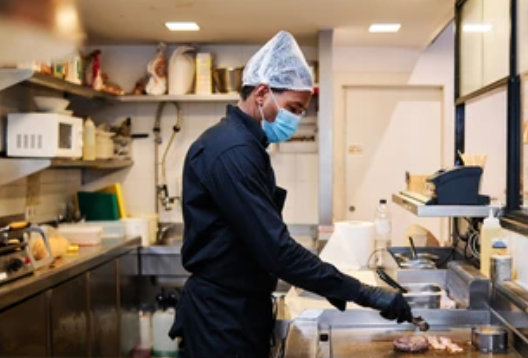Kitchens are of at least 4 types – home kitchen, roadside kitchen, restaurant kitchen and cloud kitchen. Anyone working in a kitchen is a kitchen worker and is prone to certain health risks. What are they?
We won’t discuss about the injuries that can happen in a kitchen (accidental finger cuts, fall from a height etc.), but focus on what are the health risks in a kitchen that can cause illnesses in a kitchen worker due to manual work in the short-term and long-term and what can be done to reduce them to acceptable levels.
Manual work involving repetitive tasks in awkward postures is even more a serious issue that must be addressed by awareness and training to prevent short-term and long-term effects on musculoskeletal health.
According to the World Health Organization (WHO), approximately 1.7 billion people suffer from musculoskeletal disorders globally, with lower back pain being the most common.
Ideally, a risk assessment of the kitchen should be done. If done, it becomes easier to mitigate the identified risks so that the kitchen worker’s health is not compromised.
The risk to a kitchen worker due to manual tasks are:
- Restricted spaces, heavy items stored on high or low shelves
- Trolleys that are not appropriate for the task or are poorly maintained making them difficult to push/pull
- Repetitive tasks, inadequate breaks or task variety, unreasonable timeframes/workload
Reducing the number of times (repetitiveness) necessary to do a manual task and avoiding awkward/incorrect postures improves musculoskeletal health
Ways to mitigate these risks are:
- Change the design or layout of work areas
- Reorganise the layout of kitchen to avoid unnecessary stretching and/or lifting
- Use a dishwasher or a pan and pot washer
- Improve working conditions
- Provide trolley ramps as necessary at changes in floor levels
- use 4-wheeled trolleys with adjustable height and lockable castors, if needed
- Redesign tasks
- reduce the amount of twisting, bending, stooping, stretching, pushing, and pulling
- reduce the number of times (repetitiveness) it is necessary to do the task, without increasing the load each time
- store heavy items on shelves at waist height
- use teamwork for tasks such as moving any heavy object
- Use mechanical aids
- use 4-wheeled trolleys with adjustable height and lockable castors, if needed
- Make loads easier to handle
- ensure suppliers send materials in smaller sizes and weights in containers that have built-in handles or grips, rather than in large, heavy containers/bag/boxes as it makes moving and storing on shelves easier
- similarly, use smaller containers for cleaning chemicals and/or appropriate siphons or pumps to avoid handling bulk containers
- put heavy equipment on (lockable) castors to make cleaning routines easier
If the above steps are taken risks due to manual work in the kitchen can be mitigated to ALARP (as low as reasonably practicable). This improves both short-term and long-term musculoskeletal issues (especially backache that starts with a discomfort in the back initially at the end of day’s work and progresses to either prolonged bed rest or surgery) due to repetitive tasks or handling heavy weights in awkward postures.
These risks are avoidable and improve worker health and hence efficiency.
There are other risks to health that can cause illnesses (occupational) in a kitchen worker due to thermal discomfort, ventilation etc. which will be discussed later on.
In addition, there are task-specific risks to health – food preparation, food mixers, ovens and steamers, pan and pot washing, dishwashing, cleaning and waste disposal activities, storage etc. which will be discussed subsequently in The Occupationist.
The frequency and intensity of risks to health due to manual work will vary depending on the type of kitchen and controls in place. If kitchen worker(s) are getting ill due to manual work issues, it is time to revisit the risk assessment done for the kitchen and mitigate any new risk.
Since the illnesses (health issues) occur due to work done by a kitchen worker (occupation), they are best dealt with by Occupational Health (OH) physician and/or Industrial Hygienist.
For more information, individuals, MSMEs or large kitchens may contact
_________________________________________________________________________________________________________
Dr Ajay Sati is an Occupational Health physician who prefers to describe himself as an Occupationist, to denote, ‘an expert in diseases and other concerns of occupations’. Dr Sati has managed health and wellness programs in industries he worked, like the atomic energy, and energy (oil & gas) in India and overseas. He was involved in many greenfield and brownfield projects providing inputs from health point of view. Known for SOPs and protocols, he is currently involved with an energy MNC in designing protocols to support employees during the covid pandemic, and protocols to safely reopen offices and plants.



